Phase
There are many instances in planetary science where the same material can come in different forms. An example of one such instance is shown in this picture. A diamond is one form of pure carbon, and graphite (what goes into pencil lead) is another form of the same material. They are both made of the identical substance (carbon), but they have a very different size and structure. The difference in molecular construction is referred to as the "phase" of carbon. Graphite is a different phase of carbon than that of diamond.
One might be able to imagine two different moons made out of the same amount of carbon, but one moon made of graphite and the other made of diamond. The two imaginary moons would have very different sizes! Then one might imagine one moon evolving into the other, and having to change sizes as it does so. This phenomena explains the evolution of the icy moons. Ice comes in nine different phases, and all of them have a different molecular construction. In it's evolution, an icy moon may change many times from one phase to another, or include many different phases in it's interior.
Two other materials, from the earth's interior, which exhibit similar phase differences are olivine and spinel.
You might also be interested in:
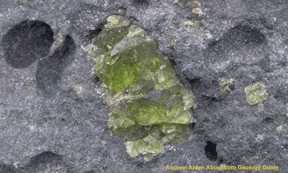
Olivine looks like little green crystals. It is typically found in some igneous and metamorphic rocks. Often the crystals are so small that you need to use your hand lens or magnifying glass to see them
...more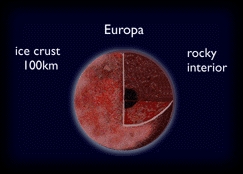
The diagram shows possibilities for the interior structure of Europa. There is a core of rocky material buried inside, overlain with ice of various phases. The diagram shows that there may be an ocean
...more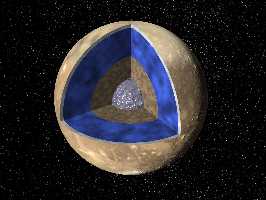
The diagram to the left shows a cutaway of the possible interior structure of Ganymede, based on recent measurements by the Galileo spacecraft. It shows a small core of metal, overlain with some rocky
...more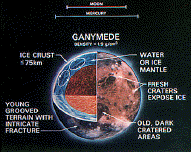
Ice can restucture itself into many different forms. The forms are called phases. Phases can be as different as diamond and graphite. As can be seen in these pictures, diamond has a very different size
...more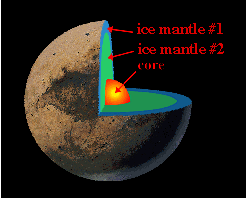
The diagram to the left shows a cutaway of the possible interior structure of Pluto. The composition of Pluto is mostly ice, therefore there is probably a small core of some rocky material buried inside,
...more
AU stands for Astronomical Units. Distances in space are too large to measure in Earth standards like miles or kilometers. For distances too large to measue in AU, we use light years. A light year is the
...more
The solar wind is formed as the Sun's topmost layer blows off into space carrying with it magnetic fields still attached to the Sun. Gusts and disturbances form in the solar wind associated with violent
...more














